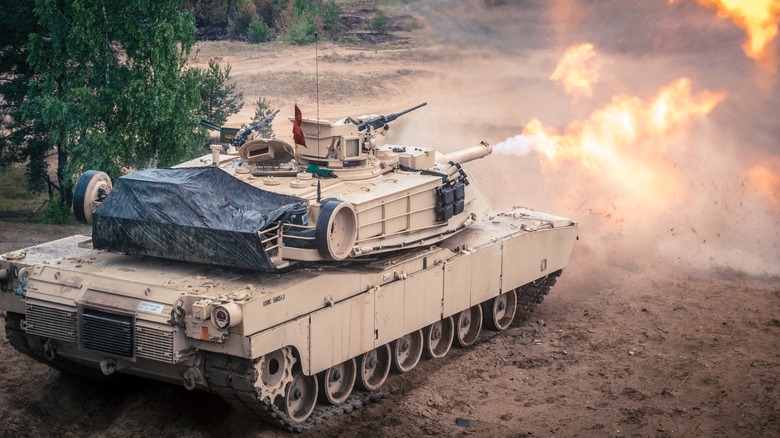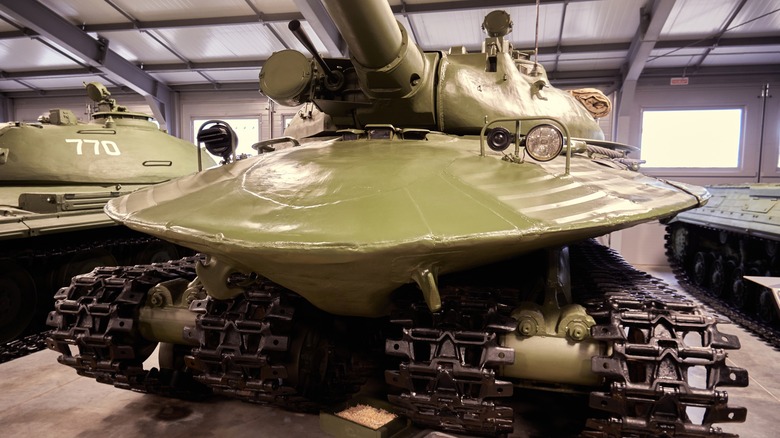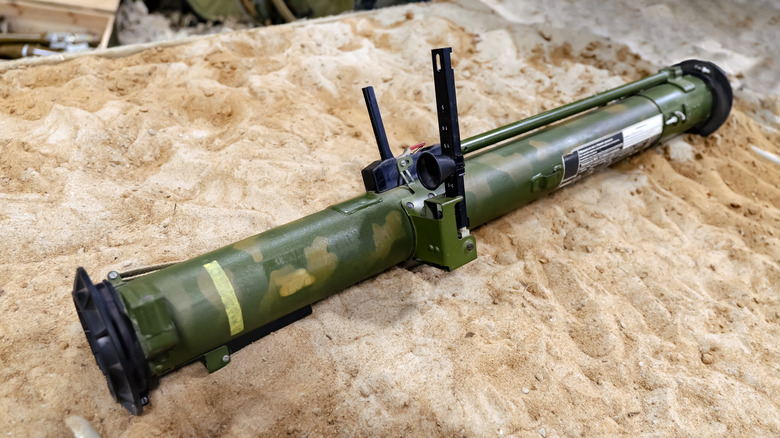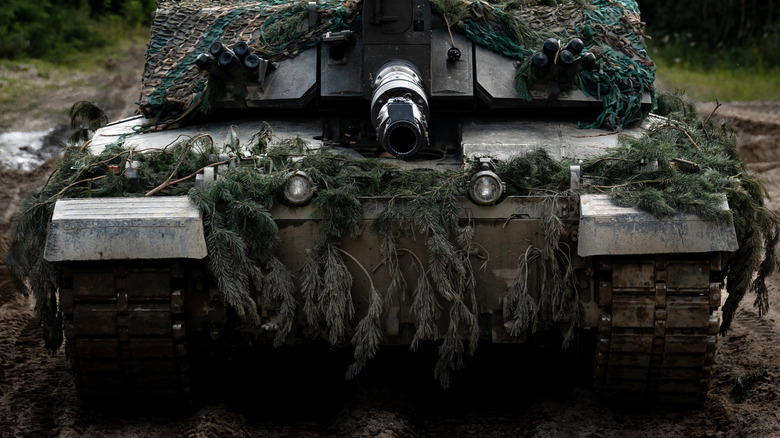Tank Trophy System Explained: What It Is And How It Works
Tanks are among the most devastating weapons ever devised. In a very real way, they have come to define warfare in the 20th and 21st centuries — rolling inexorably on their tracks and wielding formidable cannons affixed to their turrets.
Military technology, however, continually evolves. New threats are identified, weaponry is devised to counter it, and in turn, the initial threat is further developed in order to circumvent evolving problems. It's not enough for a tank to simply have a huge, varied arsenal of firepower, then. It also needs to be able to resist some of the punishment being launched back at it in response. They are, after all, not the speediest, most agile vehicles, and they're generally very big. The M1A2 model of the famed M1 Abrams tank, for instance, is a 62.5 tonne behemoth. This all adds up to what could be just a huge target without the proper protection.
Fortunately for tankers, engineers have devised some inspired solutions to the conundrum of protective measures for tanks. Here's an in-depth look at the Trophy system, how it defends tanks from attack, and how it differs from some more conventional concepts like the installation of heavier armor.
Heavier armor wasn't necessarily the answer
World War II was the conflict in which tanks eveolved to stunning capacities. Much of the success of the early German Blitzkrieg tactics revolved around the targeted implementation of tank brigades, which, of course, was particularly effective against foes without specialized anti-tank equipment. The rise of such weaponry, though, meant that the tanks needed to evolve.
The Soviet PG-70 of the latter years of the war would be developed into the RPG and M72 that were wielded to devastating effect against the vehicles of the U.S. military during the Vietnam War. Defending tanks against such threats, as they've evolved, has required considerable ingenuity. The Soviets would even create the hulking Object 279 (pictured here), an impractical yet impressive prototype tank with armor as thick as 12.5 inches and weighing in at 66 tons.
As heavy tanks gave way to medium tanks and main battle tanks, protective measures became increasingly more sophisticated than simple thickness. Electronic countermeasures to protect against blasts had to become a greater focus, to try to prevent the impacts that lightly, less heavily-armored tanks really didn't want to take. The advanced Trophy system would become one of these.
The implementation of gunpowder would render once-impenetrable castles largely obsolete as defensive powerhouses. In just the same way, armor-penetrating missiles and other artillery were unprecedented threats to tanks. Thicker layers of armor would not suffice against projectiles designed specifically to penetrate them. This doesn't mean that the armor is overall ineffective, though: Innovations like reactive armor (layers of metal with charges in between that would explode 'away' from the tank on impact), which made its combat debut in 1982, helped make them less vulnerable to a new generation of weapons.
What is the Trophy system?
The ideal scenario isn't to mitigate the damage caused to a tank by a strike, but to prevent that strike from landing altogether. Radar technology plays an role in this. It's the key to the modern APS (active protection system). The functions of such a system, first developed by theSoviet Union, are twofold: using a radar network strategically located in the tank's body to detect and locating incoming ordinance and firing a missile of its own to eliminate the threat before it arrives. The Trophy system is a sophisticated example of just such an APS.
Developed by Rafael Advanced Defense Systems Ltd. and delivered in 2011. Trophy is a powerful defensive tool and offensive weapon wrapped into one. It can detect an incoming shot, analyze the type of threat, and then dispatch the necessary firepower (from more conventional shots to a shotgun-like spread of smaller projectiles) to destroy it as it closes in.
A tank crew, in a confined space where time is often of the essence, has an incredibly difficult job to do. A miscommunication, the smallest hesitation in decision-making, or a minute miscalculation with aim can prove fatal. The Trophy system's intent is to ease this burden by taking some of the responsibility for one of a tank crew's most vital duties: Keeping track of and neutralizing opposing firepower.
The versatile system, which Rafael claims that "Trophy can be deployed on any AFVs including MBTs, 8X8s, and other medium-weight platforms," essentially consists of sensors, crew-operated hardware, and its "gun." The advanced technology has a very complicated and potentially invaluable job to do, and here's how it works.
How does the Trophy system work?
Some of the greatest threats to tanks, such as RPGs, can travel almost 275 meters in a single second. With a tank being such a large target, a single RPG wielder easily concealing themselves and the speed of the projectile once fired, it would typically be all but impossible for the crew to detect a threat, locate it, predict its path, and neutralize it, all before it hits. Trophy, as with similar systems like Russia's Arena APS, aims to accomplish all of these things.
As demonstrated in the above clip from Rafael Advanced Defense Systems Ltd., Trophy reacts to a threat detected by first figuring out what the projectile is (Threat Detection & Classification). It will then determine the flight path —if it's considered to be a legitimate on-target threat — and the best point at which to intercept it. The display will show the tank crew what's coming and where it is, but they will not need to manually engage as Trophy's weapon can fire automatically. Using its target-identifying technology, the crew can then immediately go on the offensive, given a clue then where the would-be assailants are located.
Trophy's weapon, further, is not an indiscriminate blast. The goal, an executive at Rafael told Breaking Defense in 2018, is to launch "a sniper shot.... a small number of EFPs [Explosively Formed Projectiles] in a very small area, aimed at a specific point on the warhead itself."
The performance of the Trophy system to date
In February 2018, Breaking Defense reported that 261 US M1s would be fitted with Trophy. Abrams tanks have been outfitted with it too. In September of 2023, Defense News noted that Leopard 2 tanks in Germany are also using it, as are Merkava tanks in Israel. The next generation of Challenger tanks would also employ it and are scheduled to do so by 2030. There is, in short, a lot of interest in the technology from buyers around the world. In protracted testing with the Challenger 3 tanks (following the formidable Challenger 2, pictured above) the previous year, the system neutralized at least 90% of projectiles it encountered.
Trophy has performed very well, and is perhaps less "experimental" than other APS. Rafael declares it to be "the world's only combat-proven active protection system." It can also handle multiple threats at once and assign a priority to them, through the use of its clever rotating design. It is not, however, infallible, as the likes of certain TOW 2B projectiles can jam its sensors. In addition to this, numerous simultaneous projectiles can be a greater logistical challenge to deal with, and its exclusive focus on and effectiveness against chemical energy weapons could also leave it vulnerable.
Nonetheless, APS like the Trophy have become some of the most effective defense systems tanks have ever had.



